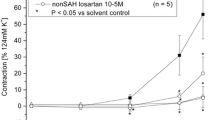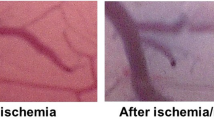Summary
The blocking effect of ketanserin, a 5-hydroxytryptamine (5-HT)2 receptor antagonist, was examined on responses to intraluminal 5-HT or potassium chloride (KC1) in isolated and perfused canine basilar arteries before and after extraluminal whole blood by means of the stainless-steel cannula inserting method. Four hours after the application of blood, the constriction to 5-HT was significantly enhanced, while that to KC1 was significantly attenuated. The absolute value in the decrease of perfusion pressure for the 5-HT-induced constriction sensitive to ketanserin was much greater after the blood application than that before the application. It is suggested that the augmentation of cerebrovascular responses to 5-HT in the early stage immediately after subarachnoid haemorrhage (SAH) might be mediated by 5-HT2 receptors at least in part. This early constrictor mechanism may be implicated in the aetiology of the following late stage of cerebral vasospasm after SAH.
Similar content being viewed by others
References
Auer LM, Leber K, Sayama I (1985) Effect of serotonin and its antagonist ketanserin on pial vessels. J Cereb Blood Flow Metab 5: 517–522
Boullin DJ, Du Boulay GH, Rogers AT (1978) Aetiology of cerebral arterial spasm following subarachnoid haemorrhage: evidence against a major involvement of 5-hydroxytryptamine in the production of acute spasm. Br J Clin Pharmacol 6: 203–215
Brawley BW, Strandness DE Jr, Kelly WA (1968) The biphasic response of cerebral vasospasm in experimental subarachnoid hemorrhage. J Neurosurg 28: 1–8
Brian JE Jr, Kennedy RH (1993) Modulation of cerebral arterial tone by endothelium-derived relaxing factor. Am J Physiol 264: H1245-H1250
Cook DA (1984) The pharmacology of cerebral vasospasm. Pharmacology 29: 1–16
Debdi M, Seylaz J, Sercombe R (1992) Early changes in rabbit cerebral artery reactivity after subarachnoid hemorrhage. Stroke 23: 1154–1162
Findlay JM, Macdonald RL, Weir BKA (1991) Current concepts of pathophysiology and management of cerebral vasospasm following aneurysmal subarachnoid hemorrhage. Cereb Brain Metab Rev 3: 336–361
Hatake K, Wakabayashi I, Kakishita E, Hishida S (1992) Impairment of endothelium-dependent relaxation in human basilar artery after subarachnoid hemorrhage. Stroke 23: 1111–1117
Kim P, Sundt TM Jr, Vanhoutte PM (1988) Alterations in endothelium-dependent responsiveness of the canine basilar artery after subarachnoid hemorrhage. J Neurosurg 69: 239–246
Krueger C, Weir B, Nosko M, Cook D, Noms S (1985) Nimodipine and chronic vasospasm in monkeys: Part 2. Pharmacological studies of vessels in spasm. Neurosurgery 16: 137–140
Mendelow AD, McCalden TA, Hattingh J, Coull A, Rosendorff C, Eidelman BH (1981) Cerebrovascular reactivity and metabolism after subarachnoid hemorrhage in baboons. Stroke 12: 58–65
Peroutka SJ, Noguchi M, Tolner DJ, Allen GS (1983) Seroto-nin-induced contraction of canine basilar artery: mediation by 5-HT1 receptors. Brain Res 259: 327–330
Sahlin C, Owman C, Chang JY, Delgado T, Salford LG, Svendgaard NA (1990) Changes in contractile rseponse and effect of a calcium antagonist, nimodipine, in isolatesd intracranial arteries of baboon following experimental subarachnoid hemorrhage. Brain Res Bull 24: 355–361
Saito A, Handa J, Toda N (1991) Reactivity to vasoreactive agents of canine basilar arteries exposed to experimental subarachnoid hemorrhage. Surg Neurol 35: 461–467
Tagari PC, Kaye AH, Teddy PJ, Schachter M, Adams CBT, Boullin DJ (1983) The 5-hydroxytryptamine antagonist ketanserin inhibits the vasoconstrictor activity of per-operative CSF, from subarachnoid haemorrhage patients, on isolated tissues. J Neurol Neurosurg Psychiatry 46: 214–220
Thompson JA, Wei EP, Kontos HA (1984) Inhibition by ketanserin of serotonin induced cerebral arteriolar constriction. Stroke 15: 1021–1024
Toda N, Ozaki T, Ohta T (1977) Cerebrovascular sensitivity to vasoconstricting agents induced by subarachnoid hemorrhage and vasospasm in dogs. J Neurosurg 46: 296–303
Tsuji T, Chiba S (1984) Potentiating effect of methysergide on norepinephrine-induced constriction of the isolated internal carotid artery of the dog. Jpn J Pharmacol 34: 95–100
Tsuji T, Chiba S (1986) Responses of isolated canine and simian basilar arteries to thiopentone by a newly designed pharmacological method for measuring vascular responsiveness. Acta Neurochir (Wien) 80: 57–61
Tsuji T, Chiba S (1987) Vasoconstrictor mechanism of 5-hydroxytryptamine in isolated and perfused canine basilar arteries. Arch Int Pharmacodyn 286: 111–122
Tsuji T, Cook DA (1987) Changes in vascular responses of isolated and perfused canine basilar arteries during early stages of experimental subarachnoid hemorrhage. Proc West Pharmacol Soc 30: 285–289
Tsuji T, Cook DA (1988) Mechanism of vascular responses to 5-hydroxytryptamine in isolated and perfused canine basilar arteries during the early stage of experimental subarachnoid hemorrhage. In: Wilkins RH (ed) Cerebral vasospasm. Raven, New York, pp 105–111
Tsuji T, Cook DA (1989) Effect of nimodipine on canine Cerebrovascular responses to 5-hydroxytryptamine and potassium chloride after exposure to blood. Stroke 20: 105–111
Tsuji T, Kobayashi S, Chiba S, Cook DA (1994) Effects of endothelium removal by saponin and of oxyhemoglobin on canine Cerebrovascular responses. J Auton Nerv Syst 49: S139-S143
Vällfors B, Dahlström A, Boström S, Ahlman H (1985) Influence of ketanserin on 5-hydroxytryptamine-induced Cerebrovascular spasm in the cat. J Cardiovasc Pharmacol 7: S60-S63
Van Nueten JM, De Ridder W, Van Gorp L, De Clerck F (1987) Vasoconstrictor expression of human platelet-vessel wall interactions: inhibition by the Ca2+ entry blocker flunarizine. Eur J Pharmacol 133: 301–308
Van Nueten JM, Janssen PAJ, Van Beek J, Xhonneux R, Verbeuren TJ, Vanhoutte PM (1981) Vascular effects of ketanserin (R 41 468), a novel antagonist of 5-HT2 serotonergic receptors. J Pharmacol Exp Ther 218: 217–230
Van Nueten JM, Leysen JE, De Clerck F, Vanhoutte PM (1984) Serotonergic receptor subtypes and vascular reactivity. J Cardiovasc Pharmacol 6: S564–574
Weir B (1987) Aneurysms affecting the nervous system. Williams and Wilkins, Baltimore
Weir B, Grace M, Hansen J, Rothberg C (1978) Time course of vasospasm in man. J Neurosurg 48: 173–178
Wendling WW, Harakal C (1987) Effects of calcium antagonists on isolated bovine cerebral arteries: inhibition of constriction and calcium-45 uptake induced by potassium or serotonin. Stroke 18: 591–598
Wilkins RH (1986) Attempts at prevention or treatment of intracranial arterial spasm: an update. Neurosurgery 18: 808–825
Young HA, Kolbeck RC, Schmidek HH (1986) Hemorrhageinduced alterations of rabbit basilar artery reactivity and sensitivity to serotonin. Neurosurgery 19: 502–506
Zervas NT, Kuwayama A, Rosoff CB, Salzman EW (1973) Cerebral arterial spasm. Modification by inhibition of platelet function. Arch Neurol 28: 400–404
Author information
Authors and Affiliations
Rights and permissions
About this article
Cite this article
Tsuji, T., Cook, D.A. Effect of ketanserin on 5-hydroxytryptamine-induced constriction in isolated, perfused canine basilar arteries exposed to blood. Acta neurochir 138, 1109–1117 (1996). https://doi.org/10.1007/BF01412316
Issue Date:
DOI: https://doi.org/10.1007/BF01412316




